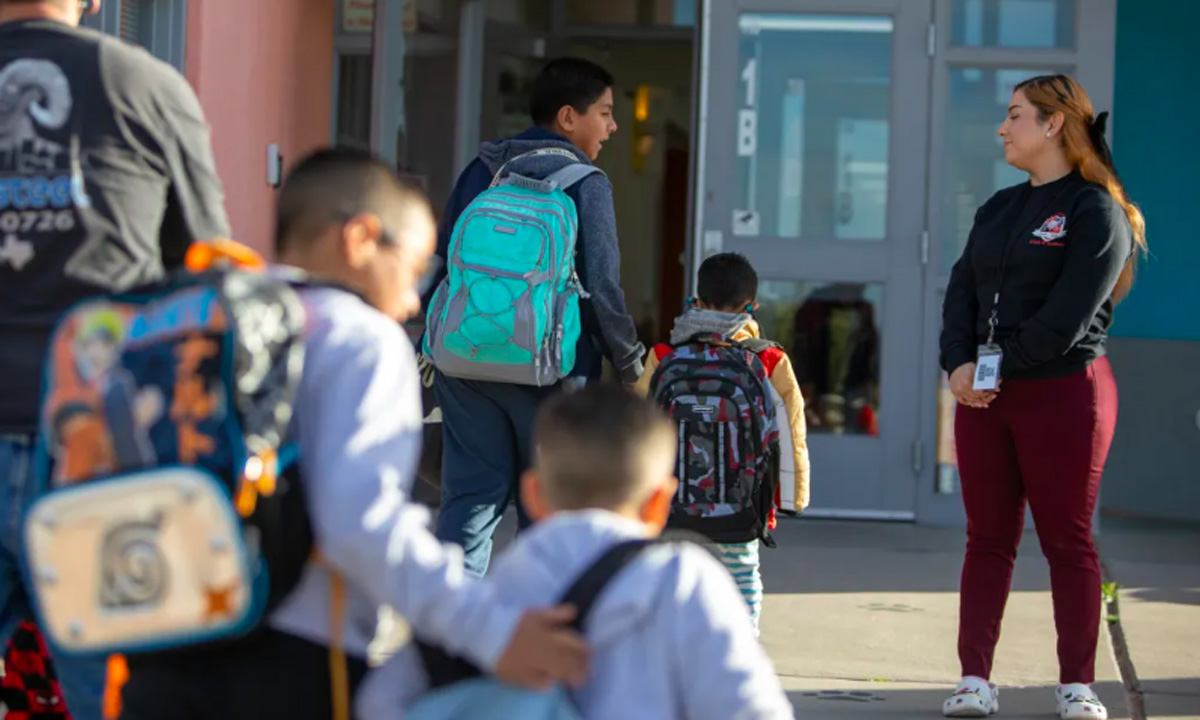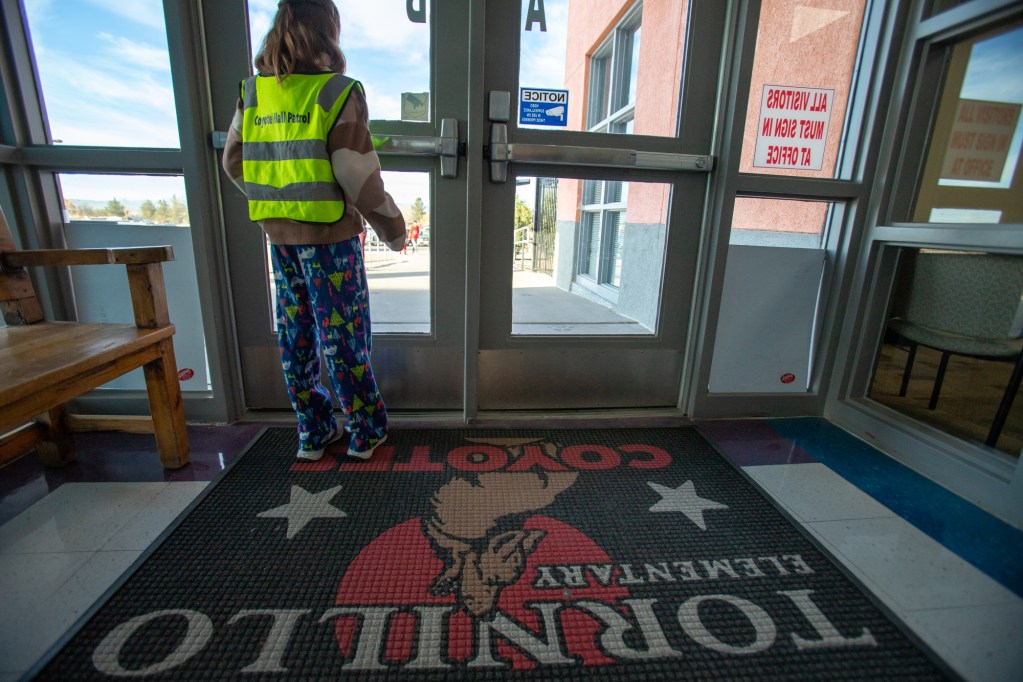Chronic Absenteeism Rises in Texas Schools Post-Pandemic
In Texas, students are considered chronically absent if they miss at least 10% — or 18 days — of a school year.

Get stories like this delivered straight to your inbox. Sign up for The 74 Newsletter
Pint-sized hall monitors in yellow neon vests greet their fellow students first thing in the morning at the Tornillo PreK-8 School as part of a program meant to encourage them to come to class every day.
As children shuffle into their classrooms, teachers begin taking counts of who’s absent the moment the school day starts at 7:30 a.m., even though attendance isn’t due until 10 a.m.
From there, it’s a sprint for staff to reach parents and find those missing students.
“Staff start making calls to parents to find out if a kid is going to be making it to school,” said Tornillo Independent School District Superintendent Rosy Vega-Barrio. “If we don’t get an answer right then and there, we send an officer to the house to find out what’s going on.”

Once a student starts accumulating absences, school leaders like Tornillo PreK-8 Principal Myrna Lopez-Patty set up meetings with parents to talk to them about Texas attendance laws, which require school districts to begin court proceedings if a student has three unexcused absences.
“You’re meeting with me as a preventive measure because we don’t want to file for court,” Lopez-Patty told parent Brenda Guillen and her son Nathan during one of those meetings in March.
Guillen said that she did not know her son could be in danger of losing credit if he missed more than 10% of his classes for the year. In the end, she said she was glad she went to the meeting before Nathan’s attendance became a bigger problem.

“I was confident with his grades. I thought he was doing great, but I completely disregarded the fact that he needed to be on time more and in school more,” Guillen told El Paso Matters.
Vega-Barrio said that these efforts helped it become the only district in El Paso County to lower its chronic absenteeism rate since students returned to school from the pandemic, although it still remained higher than pre-pandemic levels.
The 2018-19 school year was the last before the pandemic disruption. Schools across the country shut down in March 2020 and most remained closed the rest of the 2019-20 school year. In El Paso, most classes remained closed in the fall of 2020 and reopened in early 2021.
Throughout Texas, the number of chronically absent students — characterized as students who miss at least 10% of class, or about 18 days a year — rose from 11% during the 2018-19 school year to 15% in 2019-20. That increased to 26% during the 2021-22 school year, according to the most recent Federal Report Cards data released by the Texas Education Agency.
Nationally, chronic absenteeism nearly doubled from 15% in 2018-19 to 28% in 2021-22, according to a report compiled by Stanford University education professor Thomas Dee in partnership with the Associated Press.
El Paso County saw a similar trend, as chronic absenteeism rates in school districts countywide grew between 11% to 26% on average over those three years.
Tornillo ISD, a rural school district on the eastern outskirts of the county with less than 900 students, was an outlier. The district saw its chronic absenteeism rate drop from 10% in 2018-19 to 2% during the 2019-20 school year but then shot up to 22% in the 2020-21 school year. The rate dropped to 14% during the 2021-22 school year – the lowest in the county that year but still above the pre-pandemic rates
That year, the El Paso Independent School District had a 36% chronic absenteeism rate — the highest in the county. The Socorro Independent School District had a 28% rate and the Ysleta Independent School District reported a 25% rate.
Outside the city limits, 35% of students in the San Elizario Independent School District were chronically absent, with 32% in the Fabens Independent School District, 28% in the Clint Independent School District and 20% in the Canutillo Independent School District. The Anthony Independent School District kept its chronic absenteeism rate the same — at 25% — between the 2020-21 and 2021-22 school years.
Texas schools are required to keep track of which students are chronically absent, but most do not monitor the data at the district level and rely on the TEA’s annual reports.
While most El Paso schools don’t track their overall chronic absenteeism rates, some school leaders said average daily attendance has improved since the 2021-22 school year but has not returned to pre-pandemic levels.
Now some experts are concerned that this rise in absenteeism could have negative effects on students who missed out on some of the benefits of attending school every day, like getting counseling, socializing, and participating in extracurricular activities.

“The earlier students attend school consistently, in terms of their age, the more likely they’re going to graduate and go on to whatever postsecondary success looks for them,” University of Texas at Austin education professor Joshua Childs told El Paso Matters. “It can provide some structure and some organization. … It’s a place where they can get a couple of meals a day, and be around adults that care about them and engage with them. For many kids, it’s a critical component of their daily life.”
Research shows chronically absent students tend to perform worse academically and are more likely to drop out of school.
One Chicago study found that students who are chronically absent in pre-kinder, kindergarten and first grade are less likely to read at grade level by the end of the second grade.
Chronic absenteeism during the sixth grade is an indicator that a student will drop out of high school, and students who were chronically absent between eighth and 12th grade were seven times more likely to drop out, according to a 2017 TEA report.
What is chronic absenteeism and what causes it?
In Texas, students are considered chronically absent if they miss at least 10% — or 18 days — of a school year, even if an absence is excused.
States have been required to report and track chronic absenteeism to receive Title I funding since 2015 when the Every Student Succeeds Act — or ESSA — was signed into law to replace the No Child Left Behind Act. Before 2015, Texas only tracked average daily attendance, which made it hard to tell if absences were concentrated among specific students.
“What ESSA has allowed us to do is get at the frequency of students missing school and how much they’re missing,” Childs said.
Experts and educators say that in many cases, students who are absent for long periods often face obstacles that make it hard for them to get to class every day. This can include a lack of transportation, illness and personal issues that disrupt a family’s normal day-to-day lives.
San Elizario ISD Superintendent Jeannie Meza-Chavez said she has seen cases where students have lost a parent or family member and missed several days of school afterward. In another case, a family’s home burned down, leaving their children at risk of becoming chronically absent as they face potential homelessness.

The data suggests students living in poverty and those with disabilities face even more of these obstacles than their peers, keeping them from attending school regularly. In Texas, a third of economically disadvantaged students and students with disabilities were chronically absent during the 2021-22 school year.
“There’s just so many different factors,” Meza-Chavez said when asked about the causes of chronic absenteeism.”Sometimes our families just will not send kids to school.”
Because the reasons students miss school vary, Childs said educators and researchers need to dig into why students are missing school and find ways to support them.
School leaders say most districts already make efforts to address the obstacles that keep students from getting to school. Most have social workers who connect parents with outside resources. Some take matters into their own hands finding ways to help families.
At Tornillo ISD school administrators have helped students get transportation to and from school when they are unable to take the bus.
In San Elizario, counselors worked with the family that lost its home to make sure they had a place to go and the children had clothes and shoes to wear to school, Meza-Chavez said.
Why did chronic absenteeism increase?
While changes in chronic absenteeism rates varied by school district, most followed a similar pattern. Chronic absenteeism dropped slightly when the school first closed during the 2019-20 school year, likely because districts did not need to report attendance for the last few weeks of the year, said Ysleta ISD Director of Student Services Diana Mooy.

Chronic absenteeism began to rise slightly during the 2020-21 school year. At this time Texas schools worked under a hybrid model where some students could attend class online while others went in person. Mooy said chronic absenteeism didn’t rise too much in Ysleta ISD because the state gave school districts more flexibility when taking attendance to accommodate for virtual classes.
“We usually take attendance in second period, and if you’re in your seat, you’re counted present and if you’re not you’re absent. In (2021-22) we were able to take attendance later in the day so we were given more time and more opportunities to count kids present,” Mooy said.
Then chronic absenteeism skyrocketed during the 2021-22 school year when all students were required to return to school in person.
Some school leaders El Paso Matters spoke to said they saw parents keep their kids from school more often because of illness and concerns over masking and vaccination policies.
EPISD’s former truancy prevention director Mark Mendoza said he noticed a shift in families’ attitudes around school attendance.
“Before the quarantine, we had students that were chronically absent for a variety of reasons, but the general culture was that it’s important to go to school every single day,” Medoza told El Paso Matters. “Then when the pandemic happened, and the entirety of in-person schools shut down, both students and their families lost that.”
Mendoza suggested that one of the reasons EPISD has the highest chronic absenteeism rate in the county is because as a District of Innovation, it is exempt from the state law that requires students to attend 90% of their classes to get credit.

The District of Innovation concept, adopted under House Bill 1842 during the 2015 legislative session, allows school districts to excuse themselves from certain state requirements. The initiative was intended to give school districts some of the same flexibility as charter schools as long as they adopt an innovation plan.
Mendoza said that since students were allowed to miss more than 10% of their classes and still get credit as long as they got passing grades, attendance suffered.
“Many people began to have the idea that I can learn and get good grades without going to school every single day,” Mendoza said.
EPISD did not respond to a request for comment.
What did Tornillo ISD do differently?
Tornillo ISD is encompassed by expansive desert and farmland along the Rio Grande, with some families living miles from their closest neighbor.
While most schools in Texas saw their chronic absenteeism rates go up when students returned to in-person learning, the rural district saw an increase when students were learning from home. With limited broadband service in the area, district leaders said many students who could not connect to their virtual classes were counted absent.
“The majority of our kids didn’t have access to Wi-Fi,” Vega-Barrio said. “Even though we provided hotspots to every single household, you had multiple kids online at the same time and it just created a lot of issues. I think that’s what hurt us in (2020-2021).”

Additionally, the district has several students who live in Mexico and cross the Tornillo-Guadalupe International Bridge every day to get to school.
After schools closed and international travel was restricted during the pandemic, “it was really hard to get those students to partake in online learning,” Vega-Barrio said.
In many cases parents and guardians also struggled to help their kids with school work or troubleshoot technology issues, leaving them feeling like their children needed to be back in school, Vega-Barrio said.
Tornillo ISD also implemented several programs and measures in 2021 to try to reduce absenteeism including hiring an attendance officer and educating parents on the importance of not missing school.
Texas truancy courts may require parents to participate in counseling, take special classes or do community service. Parents could also face fines and up to three days in jail if they do not comply. They can also face misdemeanor charges if they are found criminally negligent for not forcing their children to go to school, according to the Texas Education Code.
Students with five or more unexcused absences in a semester can also have their enrollment revoked, which could prevent a student from graduating or progressing to the next grade.
Tornillo PreK-8 also started a morning hall patrol program to encourage students to show up to school on time every day.
“The goal was for us to get students on time but also to build leadership skills and make them feel like they had a role here in the district,” the school’s secretary, Cassandra Soto, told El Paso Matters.
Soto, who came up with the idea for the program, said she focused on students who were missing class or showing up late excessively, and those with behavioral issues. Now many of those students have improved their attendance and are eager to go to school every day.
“We’ve seen a difference in attendance and in their behavior. They actually even told me, ‘It’s our job,’ so they get here very early,” Soto said.

Tornillo ISD school leaders say these efforts have allowed them to get students back in the classroom and rebound its attendance rates.
Soto said she thinks that success can be replicated by other schools.
“We are a small district and we don’t have a lot of resources or the amount of staff other districts have. So I think that if we’re able to do it, they’re able to do it as well,” Soto said.
This article first appeared on El Paso Matters and is republished here under a Creative Commons license.
Get stories like these delivered straight to your inbox. Sign up for The 74 Newsletter

;)